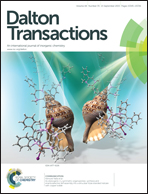Abstract
The syntheses and structures of copper(I) chalcogenone complexes are described. The homoleptic mononuclear copper(I) complexes [(IPr![[double bond, length as m-dash]](https://www.rsc.org/images/entities/char_e001.gif) E)2Cu]ClO4, IPr
E)2Cu]ClO4, IPr![[double bond, length as m-dash]](https://www.rsc.org/images/entities/char_e001.gif) E, 1,3-bis(2,6-diisopropylphenyl)imidazoline-2-thione (1) and 1,3-bis(2,6-diisopropylphenyl)imidazoline-2-selone (2); [(IMes
E, 1,3-bis(2,6-diisopropylphenyl)imidazoline-2-thione (1) and 1,3-bis(2,6-diisopropylphenyl)imidazoline-2-selone (2); [(IMes![[double bond, length as m-dash]](https://www.rsc.org/images/entities/char_e001.gif) E)2Cu]ClO4, IMes
E)2Cu]ClO4, IMes![[double bond, length as m-dash]](https://www.rsc.org/images/entities/char_e001.gif) E, 1,3-bis(2,4,6-trimethylphenyl)imidazole-2-thione (3) and 1,3-bis(2,4,6-trimethylphenyl)imidazole-2-selone (4); [(IPr
E, 1,3-bis(2,4,6-trimethylphenyl)imidazole-2-thione (3) and 1,3-bis(2,4,6-trimethylphenyl)imidazole-2-selone (4); [(IPr![[double bond, length as m-dash]](https://www.rsc.org/images/entities/char_e001.gif) E)2Cu]BF4, E = S (5); E = Se (6) and [(IMes
E)2Cu]BF4, E = S (5); E = Se (6) and [(IMes![[double bond, length as m-dash]](https://www.rsc.org/images/entities/char_e001.gif) E)2Cu]BF4, E = S (7); E = Se (8) are formed from the reduction of copper(II) to copper(I) with the corresponding imidazoline-2-chalcogenones. X-ray structure analyses of seven compounds (1–3 and 5–8) show that the copper(I) ion is in a perfect linear coordination, while 4 is in quasi-linear geometry. Molecules 2, 4, 6 and 8 are the first structurally characterized homoleptic copper(I) selone complexes. The optical and thermal properties of imidazoline-2-chalcogenones and their copper(I) derivatives are investigated. These complexes are able to act as catalysts in regioselective borylation of numerous unsymmetrical alkynes, yielding synthetically useful vinylboronates. Among catalysts 1–8, catalyst 4 is highly selective towards the regioselective boron addition of 1-phenyl-1-propyne.
E)2Cu]BF4, E = S (7); E = Se (8) are formed from the reduction of copper(II) to copper(I) with the corresponding imidazoline-2-chalcogenones. X-ray structure analyses of seven compounds (1–3 and 5–8) show that the copper(I) ion is in a perfect linear coordination, while 4 is in quasi-linear geometry. Molecules 2, 4, 6 and 8 are the first structurally characterized homoleptic copper(I) selone complexes. The optical and thermal properties of imidazoline-2-chalcogenones and their copper(I) derivatives are investigated. These complexes are able to act as catalysts in regioselective borylation of numerous unsymmetrical alkynes, yielding synthetically useful vinylboronates. Among catalysts 1–8, catalyst 4 is highly selective towards the regioselective boron addition of 1-phenyl-1-propyne.


 Please wait while we load your content...
Please wait while we load your content...